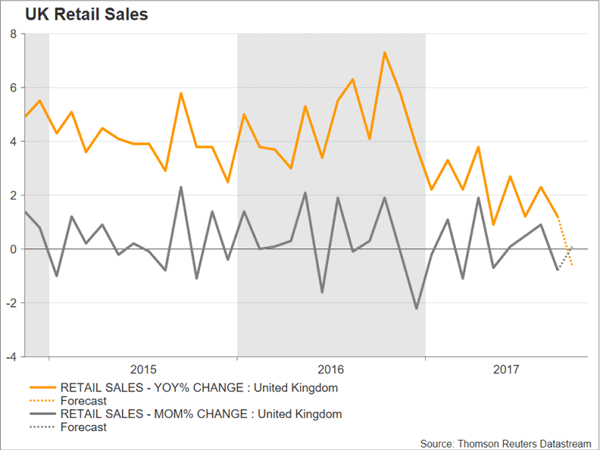Inflation readings on Tuesday suggested that British pockets will remain squeezed ahead of the Christmas shopping season, as consumer prices continued growing steadily by 3.0% in October, potentially flagging another disappointing month for retailers. With Brexit negotiations trapped in a deadlock and British real wage growth showing no signs of a significant rise, annual retail sales in October are expected to post a negative performance on Thursday, reducing the odds of another interest rate hike this year and therefore deteriorating the outlook for the British pound.
Analysts forecast retail sales to contract in October for the first time since April 2013, declining by 0.6% y/y after rising by 1.2% in September. Recall that September’s reading, which constituted the weakest growth observed since June, drove the quarterly gauge to a four-year low of 1.5%. Month-on-month, though, household spending is anticipated to recover by 0.1% following a fall of 0.8% in the previous month. Excluding auto sales and fuel, the core equivalent is estimated to slip by 0.4% y/y compared to a rise of 1.6% seen previously.
A monthly report published by the British Retail Consortium last week gave the first signs of a slowing retail sector, with like-for-like sales sinking by 1.0% in October, offsetting to a large extent the 1.9% growth seen in September. In-store sales of non-food products decreased by 2.9% over the three months to October, reaching a record low since the start of the survey in 2012. Overall, though, the survey revealed a 0.2% annual growth in the industry.

Although the British economy has to a large extent weathered the negative forecasts following the Brexit vote, uncertainty on the Brexit front firmly remains on the table, clouding the outlook. The UK and the EU Brexit negotiators have failed to reach sufficient progress in the talks, raising the probability of a cliff-edge scenario for business leaders. Lacking clarity on the UK’s future relationship with the block, firms are reluctant to pay higher wages but instead are prepared to exercise their contingency plans in case of a "hard" or no-deal Brexit. Hence, consumers might cut back on spending as their budgets come under pressure.
Unless actual numbers beat forecasts, the pound will likely move downwards to meet support at the previous bottom at 1.3023. Any violation of this point might also open the way towards August’s low of 1.2770.
Alternatively, better-than-expected readings could see the 50-day simple moving average of 1.3253 and the previous top at 1.3337 acting as resistance, while a bigger positive deviation from estimates would shift focus to the 1.35 key-level (previously a support level).















